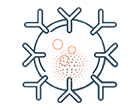Olson, H. E., Kelly, M., LaCoursiere, C. M., Pinsky, R., Tambunan, D., Shain, C., Ramgopal, S., Takeoka, M., Libenson, M. H., Julich, K., Loddenkemper, T., Marsh, E. D., Segal, D., Koh, S., Salman, M. S., Paciorkowski, A. R., Yang, E., Bergin, A. M., Sheidley, B. R., & Poduri, A. (2017). Genetics and genotype-phenotype correlations in early onset epileptic encephalopathy with burst suppression. Annals of neurology, 81(3), 419–429. https://doi.org/10.1002/ana.24883
Aeby, A., Sculier, C., Bouza, A. A., Askar, B., Lederer, D., Schoonjans, A. S., Vander Ghinst, M., Ceulemans, B., Offord, J., Lopez-Santiago, L. F., & Isom, L. L. (2019). SCN1B-linked early infantile developmental and epileptic encephalopathy. Annals of clinical and translational neurology, 6(12), 2354–2367. https://doi.org/10.1002/acn3.50921
Nashabat, M., Al Qahtani, X. S., Almakdob, S., Altwaijri, W., Ba-Armah, D. M., Hundallah, K., Al Hashem, A., Al Tala, S., Maddirevula, S., Alkuraya, F. S., Tabarki, B., & Alfadhel, M. (2019). The landscape of early infantile epileptic encephalopathy in a consanguineous population. Seizure, 69, 154–172. https://doi.org/10.1016/j.seizure.2019.04.018
Khan, S., & Al Baradie, R. (2012). Epileptic Encephalopathies: An Overview. Epilepsy Research And Treatment, 2012, 1-8. doi: 10.1155/2012/403592
Kural, Z., & Ozer, A. (2012). Epileptic Encephalopathies in Adults and Childhood. Epilepsy Research And Treatment, 2012, 1-8. doi: 10.1155/2012/205131
Radaelli, G., de Souza Santos, F., Borelli, W. V., Pisani, L., Nunes, M. L., Scorza, F. A., & da Costa, J. C. (2018). Causes of mortality in early infantile epileptic encephalopathy: A systematic review. Epilepsy & behavior : E&B, 85, 32–36. https://doi.org/10.1016/j.yebeh.2018.05.015
Spagnoli, C., Frattini, D., Rizzi, S., Salerno, G. G., & Fusco, C. (2019). Early infantile SCN1A epileptic encephalopathy: Expanding the genotype-phenotype correlations. Seizure, 65, 62–64. https://doi.org/10.1016/j.seizure.2019.01.002





